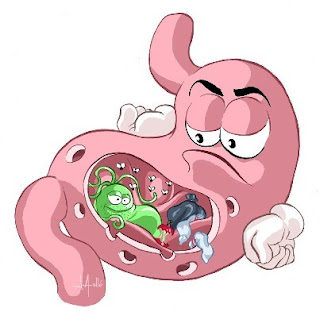Gastric pain is a common problem in our community. Try to look
around you, perhaps you can discover some of your family members or friends are
having this irritable problem. But, what is
gastric? Generally, GASTRIC,
sometimes called as DYSPEPSIA
(indigestion) is a type of stomach discomfort and pain
(stomach fullness, bloating, and nausea). Gastric can be termed as
gastrointestinal esophageal reflux disease (GERD) if it is related to acid reflux and
heartburn. Gastric can be persistent or recurrent.
Note: The
LOWER ESOPHAGEAL SPHINCTER muscles
opens (relaxes) to allow food to pass through stomach and closes (contracts) to
prevent food entry into stomach. Acid reflux occurs when the sphincter
muscle does not contracts completely, allowing gastric acid and semi-digested
food to push back into the oesophagus. Eventually, it causes heartburn,
a feeling of discomfort and burning sensation in the chest and throat,
sometimes accompanied with nausea.
What is the triggers of gastric/GERD? Who is at risk
of gastric/GERD?
Diet with high content of fats,
oils, coffee, alcohol, and citrus fruits can trigger gastric. Persistent and
intense stressful lifestyle (anger and
hostility) can increase the amount of acid in the stomach. With most of the
people living their stressful and hectic working lives, people tends to have
irregular meal that will make harm to the stomach. People with weakened immune system (kidney failure, viral
infection) have higher risk to suffer from gastric. Long-term
use of certain medication (particularly pain killers known as NSAIDs)
can increase the risk of gastric incidence. Acid reflux (GERD) and asthma are sometimes interrelated, meaning they may
trigger one another. Certain asthma medication (theophylline and
bronchodilators e.g. salbutamol) can cause esophageal sphincter muscle to
relax, allowing the stomach contents to flow back into the throat. The stomach
contents may then enter the lungs (aspiration) and irritate the airways.
How to know which type of gastric you are having? If
you have the symptoms of gastric pain, your pharmacist might dispense you some
medication but you are advised to go for a checkup to find out the cause of
gastric. The first approach of the checkup will be endoscopy
so that the doctor can observe whether there is any presence of stomach ulcer
and inflammation along the digestive tract. In this procedure, you will
required to fast or have at least 8 hours without having any meals in order to
clear your digestive tract for better visualisation. You might require to be
hospitalised in order to perform the procedure whereby a thin, flexible
telescope will put into your throat to your stomach.
If the test result
is normal with no ulcer shown, this type of gastric is termed as FUNCTIONAL DYSPEPSIA. There
is no particular cause for this gastric and mainly due to weakened lower
oesophageal sphincter, causing an acid reflux problem (can refer to the
risk/triggers of gastric above). Majority of the people suffered from
functional dyspepsia but they usually do
not benefit from gastric medication for examples H2 blockers or proton pump inhibitors (PPI).
However, they can consider antacid, which is available
over-the-counter to relieve the pain rapidly if needed. If there is
inflammation on the wall of gullet, this indicates that you are having acid reflux (GERD). On the other hand, NON-FUNCTIONAL
DYSPEPSIA can be classified if the result
shows the presence of peptic (stomach) ulcers. In this case, gastric medication
will be beneficial and further test of Helicobacter pylori (H. pylori) will be carried out.
What is H.
pylori? H. pylori is a stubborn
bacteria that have hairs to punch holes in our stomach, causing ulcers (as
shown in the picture above). This bacteria can be detected through urea breath
test, blood test or even stool sample or a biopsy sample taken during an
endoscopy. In most of the case, if H. pylori is found, then it is likely to be the cause of the ulcer. H2 blockers or proton pump
inhibitors (PPI) for acid suppression will be given along with the antibiotic as a whole course
of H. pylori treatment (at least 1
week).
If H. pylori is absent,
doctor will collect some information from you and identify the triggers of your
gastric. For instance, if you are taking pain killers for long-term, you have
higher risk in developing gastric problem and it may worsen your pre-existing
gastric problem. Pain killers (non-steroidal
anti-inflammatory drugs (NSAIDs)) for example aspirin, ibuprofen, diclofenac,
mefenamic acid, and naproxen may be the cause of your gastric. To avoid gastric problem, you are advised to take pain
killers only when necessary and not on regular basis.
If the cause is
still unknown with persistent stomachache,
accompanied with some alarming symptoms
(difficulty swallowing, weight loss, black stools and persistent vomiting with
blood), more investigation is needed. The condition can be presence of gallstone or even throat cancer (Barrett’s esophagus), stomach cancer and
liver cancer.
Infection with H.
pylori seems to be a major cause of stomach
cancer. Other risk factors could be: family history, tobacco use, and unhealthy
diet.
Alright, that’s
all for now. A full detailed of gastric medication (highlighted in light blue)
will be further discussed in Part II. Stay tuned.
Author:
Lok Ker Yee
B Pharm (Hons) (IMU)
Editors:
Ong Jijien
B Pharm (Hons) (IMU)
Tan Sue Fern
B Pharm (Hons) (IMU)
Jordy Wong Der Yuan
B Pharm (Hons) (IMU)














